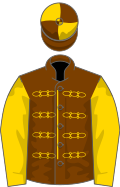| Class | Group 3 |
|---|---|
| Location | Ascot Racecourse Ascot, England |
| Inaugurated | 1919 |
| Race type | Flat / Thoroughbred |
| Website | Ascot |
| Race information | |
| Distance | 7f (1,408 metres) |
| Surface | Turf |
| Track | Straight |
| Qualification | Three-year-olds |
| Weight | 9 st 1 lb Allowances 3 lb for fillies Penalties 5 lb for G1 / G2 winners 3 lb for G3 winners |
| Purse | £110,000 (2022) 1st: £65,120 |
| 2025 | ||
 |  |  |
| Noble Champion | Spy Chief | Comanche Brave |
| Previous years | ||
|---|---|---|
| 2024 | ||
 |  |  |
| Haatem | Kikkuli | Chicago Critic |
| 2023 | ||
 |  |  |
| Age Of Kings | Zoology | Streets Of Gold |
| 2022 | ||
 |  |  |
| Noble Truth | Find | Dubai Poet |
| 2021 | ||
 |  |  |
| Creative Force | Naval Crown | Vadream |
| 1990-1988 | ||
|---|---|---|
| 1990 | ||
 |  |  |
| Sally Rous | Bold Russian | Qui Danzig |
| 1989 | ||
 |  |  |
| Zilzal | Russian Royal | Distant Relative |
| 1988 | ||
 |  |  |
| Indian Ridge | Salse | Hibernian Gold |
The Jersey Stakes is a Group 3 flat horse race in Great Britain open to three-year-old horses. It is run at Ascot over a distance of 7 furlongs (1,408 metres), and it is scheduled to take place each year in June.
Contents
The event was established when a three-year cycle of races called the Triennial Stakes was discontinued after World War I. The Triennial Stakes had comprised a race for two-year-olds over 5 furlongs, a race for three-year-olds over 7 furlongs, and a race for four-year-olds over 2 miles. Horses would return each year to compete over the increasing distances.
The Jersey Stakes replaced the second leg of the Triennial Stakes in 1919. It was named after the 4th Earl of Jersey, who served as the Master of the Buckhounds in the late eighteenth century.
The race is now run on the final day of the five-day Royal Ascot meeting.






















































